Laser Tattoo Removal


What is the Latest Technology in Laser Tattoo Removal?
Picosecond lasers such as PicoSure and PicoWay are the latest technology in tattoo removal. Pico lasers use extremely short pulses (billionths of a second) of laser energy to break up tattoo ink to provide better results with less risk as compared to older technology.


Our PicoWay laser has the highest peak power and shortest pulse duration of all current picosecond lasers available in North America.
People often come to us for laser tattoo removal, as tattoos have become so popular and commonplace in today’s society. It seems like tattoo shops are everywhere and there must be close to 100 of them in Edmonton.

Tattoos are often embedded in the skin for artistic reasons but can also be caused by trauma, such as falling off a bike or motorcycle. Every day we see patients from every walk of life who have second thoughts about their tattoo. Fortunately, advanced laser technology allows us to remove traumatic and artistic tattoos safely without leaving a scar. When the dirt or ink particles from a tattoo absorb laser energy, the pigment is broken up into tiny fragments. These fragments are then removed through the body’s natural cleansing mechanism leaving behind normal skin.
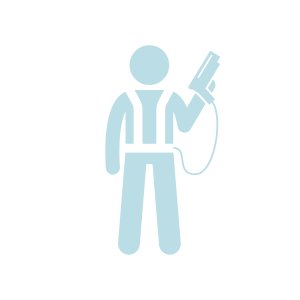
Tattoo removal requires expertise and a variety of wavelengths as different pigments require different wavelengths of light to remove them.Optimal tattoo removal also requires extremely short laser pulse durations as this produces the least heat transfer to the surrounding tissue and breaks the pigment into smaller particles.
For example, green ink will generally not respond well to a 532 nm laser but will respond well to a 785 nm wavelength. Black tattoo ink responds extremely well to a 1064 nm laser.

What’s New in Laser Tattoo Removal?
At our laser clinic in Edmonton, we have used many different lasers for tattoo removal over the last 20 years. Our newest laser is PicoWay ® and we have found it to be faster and more effective than our previous pigment removal laser (the Alex TriVantage). This new laser uses three wavelengths (532 nm, 785 nm, and 1064 nm) to treat tattoos. The different wavelengths allow us to effectively treat a variety of colours as each wavelength is better at removing different colours.

PicoWay is one of the newest generation of picosecond lasers and has the shortest pulse duration and highest peak power of all current picosecond lasers available in North America.
The PicoWay laser is extremely effective at treating tattoos. We have even been able to help remove tattoos resistant to other tattoo removal lasers. We are extremely happy with this laser. Some lasers do not live up to expectation but this laser most definitely lives up to our expectations.
Eyebrow Tattoos
Although eyebrow tattoos are not new, we are definitely seeing a big increase in the number of eyebrow tattoo laser removal patients that we are seeing.
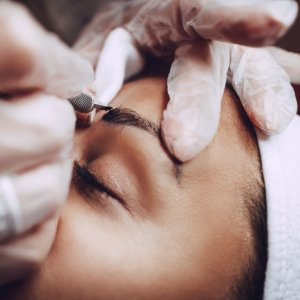
The number of eyebrow tattoos has increased over the years. Newer alternatives such as microblading have increased interest in tattooing of the eyebrows. Interestingly, many patients do not consider microblading a type of tattoo but the micoblading technique is just a different way of inserting tattoo ink particles into the skin. Another interesting aspect about eyebrow tattoos is that they can be a little more difficult to eradicate. Many of the eyebrow tattoos we treat change from brown to red after the first treatment, then sometimes to yellow after further. We often have to adapt our treatment parameters to account for the changes in pigment.
How do you decide if a patient is a good candidate for laser hair removal?
As with all our laser treatments, we consider many factors and first do a focused history and physical to elicit the necessary information, including but not limited to:
- TYPE OF TATTOO: factors such as professional vs. amateur vs. traumatic, colours, location, size, age
- MEDICAL CONDITIONS: such as vitiligo and other koebnerizing conditions, history of scar
- MEDICATION HISTORY
- SKIN TYPE
- PRESENCE OF TAN
Before and After Photos of Laser Tattoo Removal
**Actual patients. Individual results may vary.
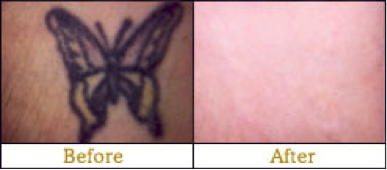
**Actual patients. Individual results may vary.
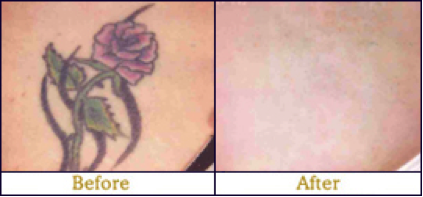
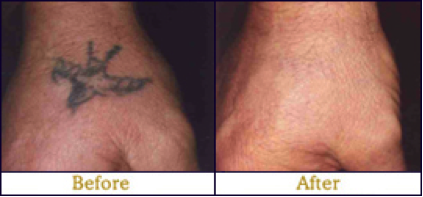
**Actual patients. Individual results may vary.
Frequently Asked Questions
How Does Laser Tattoo Removal Work?
The intense laser light passes through the top layer of the skin to the second layer of the skin, where it is selectively absorbed by the pigment particles within the skin. The energy emitted by the laser light when it is absorbed causes the targeted pigment to break into minuscule particles that are removed by the body’s immune “garbage collecting” system. Because of this guided missile-like capacity, the surrounding tissue remains intact significantly reducing the risk of scarring and pigment change.
Do Treatments With the Laser Hurt?
Patients at our laser clinic in Edmonton often ask about the pain of tattoo removal. The light from the laser is emitted in pulses. Each pulse feels like someone has snapped an elastic band against the skin. People vary in their level of pain tolerance. An anesthetic cream, such as EMLA, can be obtained from a pharmacy and applied before the treatment for people with low pain tolerances.
If requested, we can also inject local anaesthetic so the treatment can be completely pain free.
How Does the Skin Look and Feel After a Treatment with the Laser?
Each pulse of the laser light leaves the targeted skin with a grey appearance. There may be some superficial bleeding. Subsequent blistering and crusting is resolved as the top layer of skin turns over. The length of time it takes for the crust to be sloughed depends on the depth of the pigment in the skin and the location of the tattoo on the body. The pigment does not necessarily fade evenly and several sessions may be required before all the pigment disappears.
How Many Treatments are Required and What Will it Cost?
The number of treatment sessions depends on the size, location, depth, and colour of the tattoo. These factors also determine the cost. Professional tattoos usually require more sessions than amateur tattoos because of the complexity of the colours in the ink, and the depth at which the ink penetrates the skin.
Treatment sessions are spaced three to six weeks apart. This allows the garbage collecting cells of the immune system to gather up the maximum amount of left over pigment between each session.
Are Laser Tattoo Removal Lasers Safe?
Yes, these lasers are safe. Safety goggles must be worn by both the patient and the laser surgeon during the procedure to protect the eyes from the bright light.
A potential complication with this procedure is hypo-pigmentation where the treated area ends up being lighter than the surrounding tissue. The risk of scarring is very low because the laser light is absorbed by the targeted pigment, leaving the surrounding tissue relatively untouched.
Moreover, new picosecond lasers produce less heat because their pulse duration is so short, making them even safer than previous generations.
What are My Tattoo Removal Options?

Over the years. many different treatment approaches have been tried, including:
- Chemical/Mechanical abrasion
- Surgical excision
- Chemical and thermal destruction
- Early lasers, such as Argon and CO2
- Q-switched lasers: ns duration
- Pico lasers: ps duration
Is There a Tattoo Removal Cream?
There is no cream that will increase the body’s ability to remove tattoo ink and cream that will dissolve or otherwise remove the tattoo ink embedded into the skin.
Do you have another question that wasn’t addressed here? Please feel free to contact us with any questions or concerns you may have!
